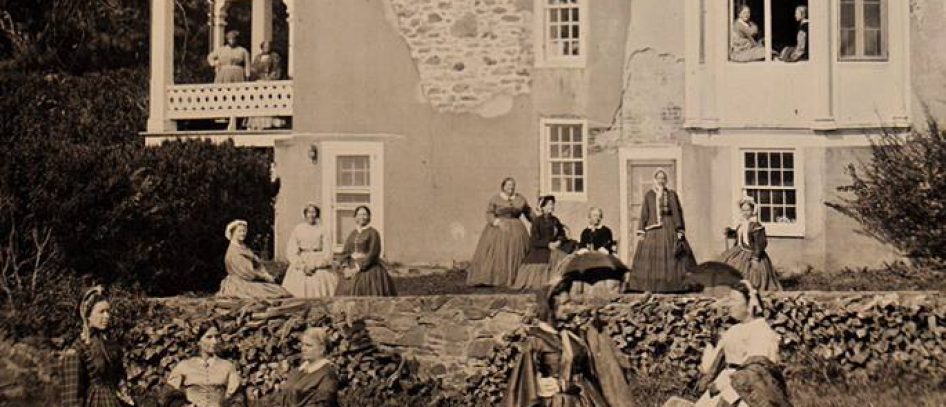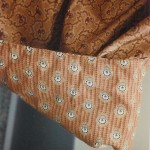The information here is taken from Vicki Betts’ presentation “Clothing for the Working Woman”. Used with her permission.
I know how bad it is, to desire to go into company and forced to stay at home for the want of proper apparel.” 1864.
A Rebel Wife in Texas: The Diary and Letters of Elizabeth Scott Neblett 1852-1864
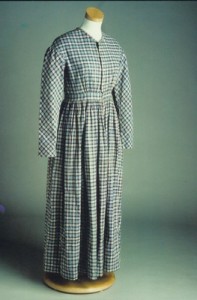 Often called a camp or work dress in the reenactor community, this type of dress is worn whenever you will get either sweaty or dirty, such as cooking, washing clothes, soap making, heavy house cleaning, working in the garden or with livestock, dealing with young children, nursing when required or, in larger towns, when visiting public markets to purchase food. It is important to know that the term “camp” dress is not found in period accounts. Rather, if you are visiting camp, you are probably dressed in your best to give a good impression for the men. An exception would perhaps be a laundress, but still “camp” dress is not a term used.
Often called a camp or work dress in the reenactor community, this type of dress is worn whenever you will get either sweaty or dirty, such as cooking, washing clothes, soap making, heavy house cleaning, working in the garden or with livestock, dealing with young children, nursing when required or, in larger towns, when visiting public markets to purchase food. It is important to know that the term “camp” dress is not found in period accounts. Rather, if you are visiting camp, you are probably dressed in your best to give a good impression for the men. An exception would perhaps be a laundress, but still “camp” dress is not a term used.
Work dresses are almost never seen in fashion magazines or photographs of the time and they seldom survive in museums. However, you will find mention of them in diaries and letters from the war years. Women at all social levels appeared to own at least one work dress.
A w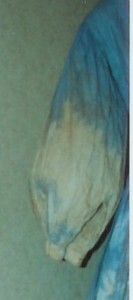 ork dress is made from cotton calico, wool or homespun. Your work dress should not be in perfect condition; a few patches, missing buttons, even discolorations are acceptable. This is especially true for late war impressions. As prices for fabric rose, dresses were made over and repaired.
ork dress is made from cotton calico, wool or homespun. Your work dress should not be in perfect condition; a few patches, missing buttons, even discolorations are acceptable. This is especially true for late war impressions. As prices for fabric rose, dresses were made over and repaired.
See the Fabric page for examples of appropriate fabric patterns and colors.
Bodice
Bodice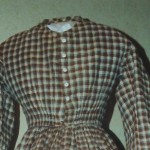 s for work dresses are generally lined and hav
s for work dresses are generally lined and hav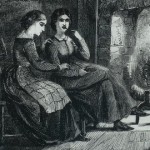 e piping at the neckline, armscye, bottom of waistband, and at the wrist of coat sleeves. Work dresses can have collars or you can wear a scarf at the neck.
e piping at the neckline, armscye, bottom of waistband, and at the wrist of coat sleeves. Work dresses can have collars or you can wear a scarf at the neck.
Sleeves
Work dresses need sleeves that could be rolled up out of the way. Both the coat sleeve and the bishop sleeve were used on original work dresses.
Skirt
The skirt 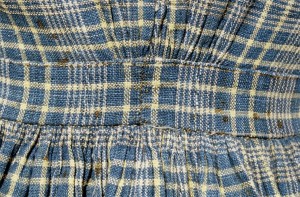 of the work dress is full all around and gauged into the waist of the bodice. Heavy homespun is sometimes gathered into the waist rather than gauged.
of the work dress is full all around and gauged into the waist of the bodice. Heavy homespun is sometimes gathered into the waist rather than gauged.
Gauging
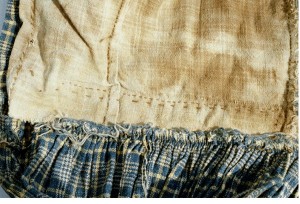 Fold over the top of the fabric at least an inch, run two exactly parallel lines of hand stitching through both layers, then stitch the top of each accordion fold into the bodice or waistband by hand. (The gauging pictures are details of the Furr Homespun Dress, owned by Vicki Betts.)
Fold over the top of the fabric at least an inch, run two exactly parallel lines of hand stitching through both layers, then stitch the top of each accordion fold into the bodice or waistband by hand. (The gauging pictures are details of the Furr Homespun Dress, owned by Vicki Betts.)
Pocket
Often only one, set into the seam on the side of the front skirt panel. A separate pocket worn around the waist under the skirt is primarily a pre-Antebellum accessory.
Skirt Hem
No more than 4” above ground and faced for dress protection and fullness. Hem facing can be of scraps. Hem braid, usually wool, also on the bottom edge to protect it from wear. The hem can also use be turned up as work dresses are shorter than nicer dresses.
The hem circumference is between 120 inches and 140 inches. The skirt is usually plain with no decoration or embellishment and usually unlined due to the heavier fabric used.
